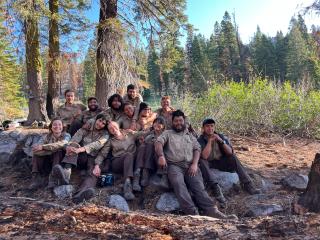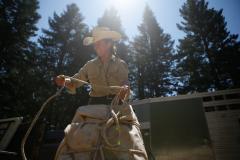By Andrew Avitt, August 16, 2022

Editor’s note: The Backcountry Trails Program, established in 1979, is the longest-running special program of the California Conservation Corps. For two decades, the program, in partnership with AmeriCorps, has provided a path for those looking to pursue a career in the Forest Service.
There are nearly 160,000 miles of trails on national forests and grasslands across 43 states and Puerto Rico, giving people access to activities like camping, fishing, and peak bagging.

Although these mostly dirt trails may seem simple, not much to look at or think about, the work to build these trails and maintain them is tough. The work requires proper planning to ensure minimal adverse effects on the land and many hours of physical labor. The Forest Service can’t do it alone. Partners and volunteers are critical to this work. In California, one organization and many crewmembers are taking that collaboration to the next level.
The California Conservation Corps recruits about 90 people each year to live and work off the grid in the wilderness for five months building new trails and restoring old ones affected by wildfire and erosion.
One Back Country Trails crew of 13 is currently living and working in the Trinity Alps Wilderness on the Shasta-Trinity National Forest. Although crew members come from all over the country and from diverse backgrounds, they share grit and an adventurous spirit.
“Being out here is a change of pace for a lot of us,” said Chris Caylor a crewmember from Pomona, California. “Some of us are coming from larger cities, so going from the middle of a city to living in a tent for five months, it definitely calls to a different type of person. I love the opportunity it provides and the challenge physically and mentally.”
Working in wilderness areas comes with its own set of rules. Operation of motorized equipment is not allowed on these lands unless there’s an emergency. This means that crew members restore and build these new trails using hand tools, including shovels, picks, and hand saws, the equipment they or Pack Stock Center of Excellence mules must carry in. So, living in the backcountry for several months on end is the most efficient way to build these trails by traditional means.
“The opportunity to be out in the wilderness to do this work? It’s hard but worth it,” said Cedar Long, backcountry crew supervisor with the California Conservation Corps. “You have to prepare to be uncomfortable and learn how to embrace that. But you will learn amazing things about yourself. You’ll be challenged to do new things that you’re not sure you can do yet. And you’ll find that you can, in fact, do them, and do them well.”
Mckenna Pipkin, a crew member from Fresno, California, shared similar advice given to her before she started.

“It’s going to be one of the hardest things that you’ve ever done in your life, but you’re going to come out of it as one of the best versions of you that you’ve ever been,” Pipkin said. “It’s going to challenge you in ways that you didn’t think it would. It’s going to make you see different perspectives. Sometimes it’s going to make you want to cry. But your supervisor is there, and your crew members are there, and you learn that you’re so much stronger than you know.”
Aaron McBride is one of the Back Country Trails Program sponsors with the Forest Service. He spends most days out with the crew offering technical direction on sustainable land management practices.
For example, he said, “We are trying to eliminate some of these older trails that run through sensitive meadow systems, so we try to reroute those trails from softer meadows and sensitive grasses to higher sustainable places.”
McBride got his start in the program as a corps member himself just seven years ago. He served as a backcountry supervisor in 2016 and 2018. The experiences, he said, kept him coming back for more. Ultimately, many crew members continue working in the conservation field and some with the Forest Service.
With a couple months still to go, the backcountry trail crew occasionally thinks about the future: What will they do when they leave? Ideas included applying for jobs in wildland firefighting or land management with agencies like the Forest Service. Or even going back to school to study natural resource management. Some also joked that they were happy in the wilderness and that they might not leave.
These Trinity Alps Back Country crewmembers are just one in a long line of adventurous conservationists. Since 1979, these crews have worked on national forests in California, maintaining 11,406 miles of trail, building 92,622 feet of new trails, and building 10,674 rock or log waterbars that help fight erosion. Crews also built foot and stock bridges and helped in search and rescue missions.

Their work extends beyond national forests to other public lands such as federal and state parks. Over the years, estimates show about 3,200 program members have performed more than 2.2 million hours of trail work.
For those interested in this hands-on, adventurous pursuit, the crew had some words of advice. “Do it. Even if they don’t think they are physically or mentally capable,” said Nora Weaver from Fortuna, California., “You learn that anything is possible with the right mindset. You realize you only need the bare necessities in life to be happy while you’re out here. And it’s a powerful lesson not just for your body, but your mind.”
“I think it’s a program that anyone could benefit from,” said Maddie Buel, from Chicago, Illinois. “It’s rare that we find ourselves in a setting completely free of distractions and the hustle and bustle of the outside world. Here in the wilderness, we don’t have phones. We don’t have TV or music. We have each other, the mountains and the wilderness. It’s an amazing opportunity to get in touch with yourself and to grow.”
For more information on how to join the Backcountry Trails Program and the California Conservation Corps visit Backcountry Trails Program in partnership with Americorps | California Conservation Corps